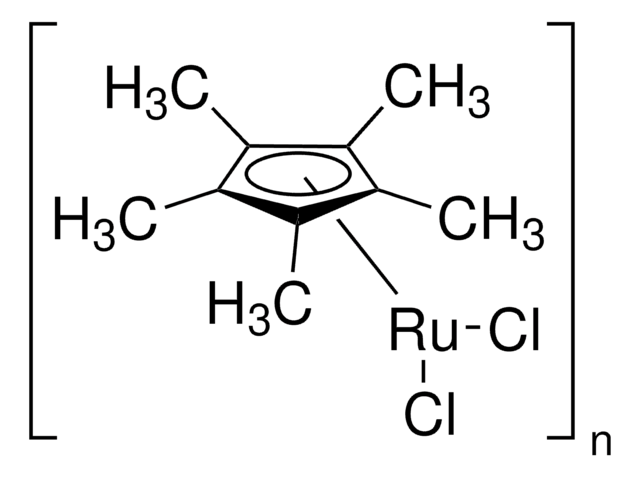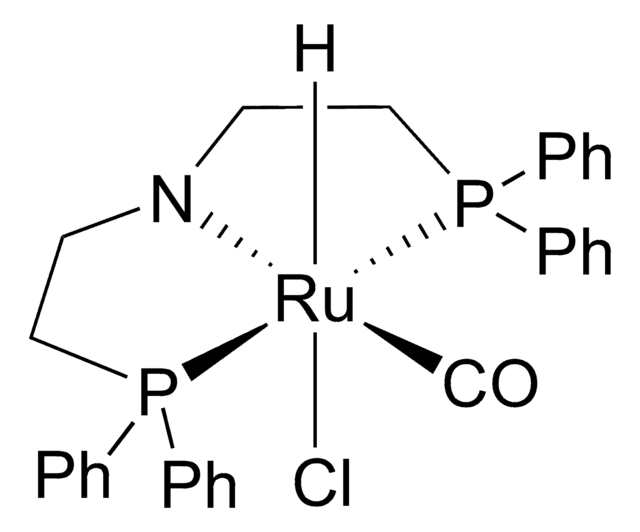Products may be shipped at a different temperature than the recommended long-term storage temperature. If the product quality is sensitive to short-term exposure to conditions other than the recommended long-term storage, it will be shipped on wet or dry-ice. If the product quality is NOT affected by short-term exposure to conditions other than the recommended long-term storage, it will be shipped at ambient temperature. As shipping routes are configured for minimum transit times, shipping at ambient temperature helps control shipping costs for our customers. For more information, please refer to the Storage and Transport Conditions document: https://www.sigmaaldrich.com/deepweb/assets/sigmaaldrich/marketing/global/documents/316/622/storage-transport-conditions-mk.pdf
667234
Chloro(pentamethylcyclopentadienyl)(cyclooctadiene)ruthenium(II)
Sinonimo/i:
Cp*RuCl(cod), 1,5-Cyclooctadiene, ruthenium complex, Chloro(1,5-cyclooctadiene)(η5-pentamethylcyclopentadienyl)ruthenium, Chloro(1,5-cyclooctadiene)(pentamethylcyclopentadienyl)ruthenium
About This Item
Prodotti consigliati
Impiego in reazioni chimiche
core: ruthenium
reagent type: catalyst
Livello qualitativo
Punto di fusione
143-147 °C
Temperatura di conservazione
−20°C
Stringa SMILE
Cl[Ru].C1CC=CCCC=C1.C[C]2[C](C)[C](C)[C](C)[C]2C
InChI
1S/C10H15.C8H12.ClH.Ru/c1-6-7(2)9(4)10(5)8(6)3;1-2-4-6-8-7-5-3-1;;/h1-5H3;1-2,7-8H,3-6H2;1H;/q;;;+1/p-1/b;2-1-,8-7-;;
MQMQNIQJGNBEMG-ONEVTFJLSA-M
Categorie correlate
Applicazioni
It can be used:
- To catalyze cyclotrimerization of alkynylboronates, propargyl alcohols, and terminal alkynes to form arylboronate, which in turn undergoes palladium(II)-catalyzed carbonylation to form highly substituted phthalides.[2]
- To catalyze C-C coupling of norbornenes and norbornadiene with alkynes to form [2 + 2] cycloadducts.[3]
- In combination with 2-diphenylphosphinoethylamine-potassium tertiary butoxide to form a ternary catalyst system that can catalyze fast racemization of chiral non-racemic sec-alcohols.[4]
- To synthesize new organoruthenium complexes with phosphorus-based ligands such as bis(phosphino)amines.[5]
- To catalyze the addition of organic disulfides to alkenes leading to vic-dithioethers.[6]
Avvertenze
Danger
Indicazioni di pericolo
Consigli di prudenza
Classi di pericolo
Water-react 2
Codice della classe di stoccaggio
4.3 - Hazardous materials which set free flammable gases upon contact with water
Classe di pericolosità dell'acqua (WGK)
WGK 3
Punto d’infiammabilità (°F)
Not applicable
Punto d’infiammabilità (°C)
Not applicable
Dispositivi di protezione individuale
Eyeshields, Gloves, type P3 (EN 143) respirator cartridges
Scegli una delle versioni più recenti:
Possiedi già questo prodotto?
I documenti relativi ai prodotti acquistati recentemente sono disponibili nell’Archivio dei documenti.
I clienti hanno visto anche
-
How is shipping temperature determined? And how is it related to the product storage temperature?
1 risposta-
Utile?
-
-
How can I determine the shelf life / expiration / retest date of this product?
1 risposta-
If this product has an expiration or retest date, it will be shown on the Certificate of Analysis (COA, CofA). If there is no retest or expiration date listed on the product's COA, we do not have suitable stability data to determine a shelf life. For these products, the only date on the COA will be the release date; a retest, expiration, or use-by-date will not be displayed.
For all products, we recommend handling per defined conditions as printed in our product literature and website product descriptions. We recommend that products should be routinely inspected by customers to ensure they perform as expected.
For products without retest or expiration dates, our standard warranty of 1 year from the date of shipment is applicable.
For more information, please refer to the Product Dating Information document: https://www.sigmaaldrich.com/deepweb/assets/sigmaaldrich/marketing/global/documents/449/386/product-dating-information-mk.pdfUtile?
-
Filtri attivi
Il team dei nostri ricercatori vanta grande esperienza in tutte le aree della ricerca quali Life Science, scienza dei materiali, sintesi chimica, cromatografia, discipline analitiche, ecc..
Contatta l'Assistenza Tecnica.








![Dichlorotriphenylphosphine[2-(diphenylphosphino)-N-(2-pyridinylmethyl)ethanamine]ruthenium(II) 97%](/deepweb/assets/sigmaaldrich/product/structures/303/584/056e7e0c-3dde-4c68-9250-78fed40d37cb/640/056e7e0c-3dde-4c68-9250-78fed40d37cb.png)





